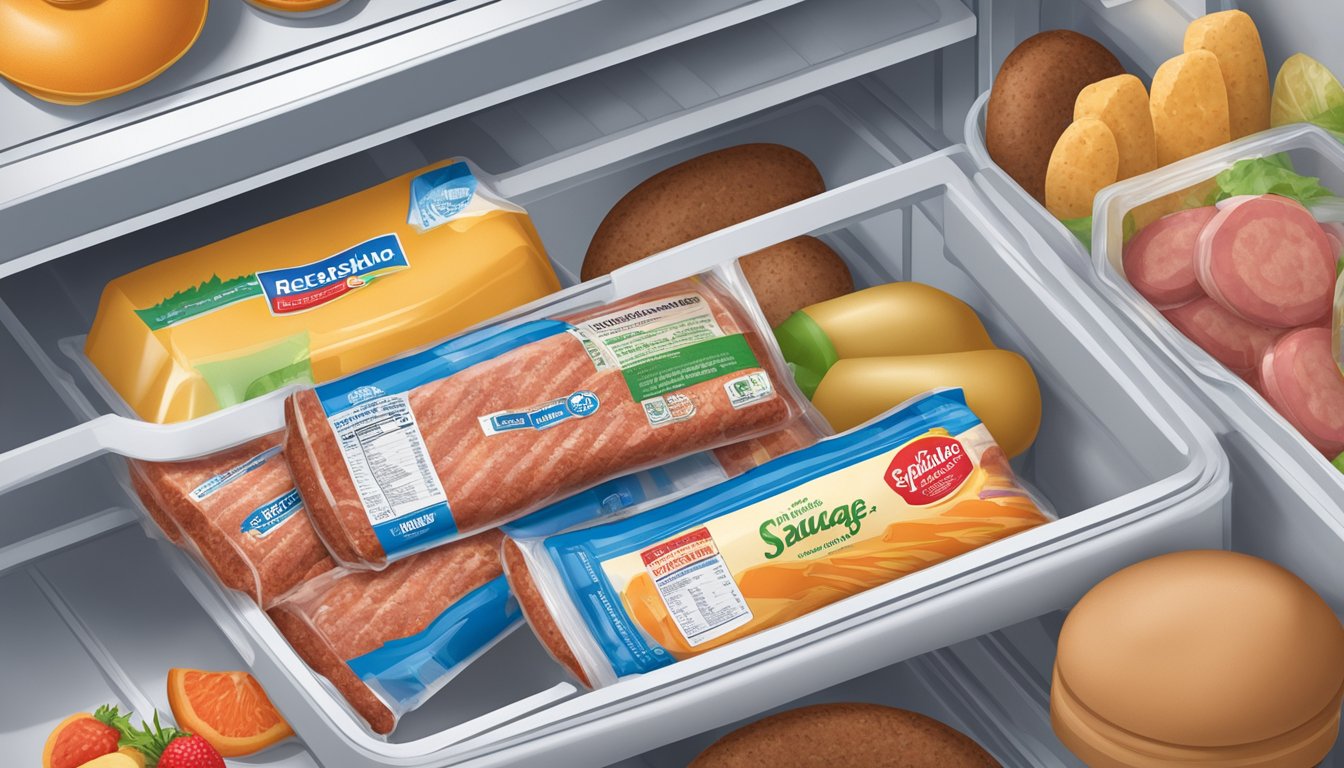Breakfast sausage is a beloved morning staple, but like all perishable foods, it can spoil if not properly stored or consumed within a reasonable timeframe. Fresh breakfast sausage typically lasts 1-2 days in the refrigerator or up to 2-3 months in the freezer when stored properly.
Recognizing the signs of spoilage is crucial for food safety and preventing potential illness. Consumers should be aware of key indicators such as changes in color, odor, and texture that signal breakfast sausage has gone bad. Gray or brown discoloration, a rancid smell, or a slimy surface are all red flags that the sausage should be discarded.
While expiration dates provide helpful guidelines, they are not foolproof. It’s important to use sensory cues in conjunction with these dates to determine if breakfast sausage is still safe to eat. When in doubt, it’s always best to err on the side of caution and discard any sausage that seems questionable.
Understanding Breakfast Sausage

Breakfast sausage is a popular morning protein that comes in various types and requires proper storage for food safety. Knowing the composition and storage methods helps ensure quality and prevent spoilage.
Types and Composition
Breakfast sausage typically contains ground pork, though beef and poultry varieties exist. Seasonings like sage, thyme, and black pepper give it a distinct flavor. Fresh sausage has a pink or red color and slightly moist texture.
Pre-cooked versions are also available. Some contain preservatives to extend shelf life. Vacuum-sealed packages can last longer than those in regular packaging.
Proper Storage Methods
Refrigeration is crucial for fresh breakfast sausage. Unopened packages can last 1-2 weeks in the fridge. Once opened, use within 3-5 days. For longer storage, freezing is recommended.
Frozen sausage maintains quality for 2-3 months. Thaw in the refrigerator before cooking. Cooked sausage can be refrigerated for 3-4 days or frozen for up to 4 months.
Always check for signs of spoilage before consuming. Proper handling and storage are key to maintaining food safety and quality.
Identifying Spoiled Sausage
Recognizing spoiled breakfast sausage is crucial for food safety. Several key indicators can help determine if sausage has gone bad and should be discarded.
Visual Cues
Fresh breakfast sausage typically has a pinkish-red color. Any discoloration, such as gray, green, or brown hues, suggests spoilage. Mold growth is another clear sign – even small spots indicate the sausage is unsafe to eat.
Texture changes can also be visible. Good sausage should appear firm and slightly moist. If the sausage looks slimy or has an excessive amount of liquid, it’s likely spoiled. Swelling in the packaging can indicate bacterial growth and gas production.
Freezer burn, characterized by white or grayish patches, doesn’t necessarily mean the sausage is unsafe, but it can affect quality and taste.
Olfactory Indicators
A healthy breakfast sausage has a mild, meaty aroma. Any sour, pungent, or off-putting odor is a red flag for spoilage. The smell of spoiled sausage is often described as rancid or unpleasant.
If the sausage emits a strong, sour odor upon opening the package, it’s best to err on the side of caution and discard it. Trust your nose – it’s often the first line of defense against consuming spoiled food.
Tactile Signs
The texture of sausage can reveal a lot about its freshness. Fresh sausage should feel firm to the touch. If it feels slimy, sticky, or unusually soft, these are indicators of bacterial growth and spoilage.
When cooking, pay attention to how the sausage feels. Spoiled sausage may have a mushy or grainy texture. If the sausage feels off in any way during preparation or cooking, it’s safer to discard it.
Remember, when in doubt about the safety of breakfast sausage, it’s always better to throw it out rather than risk foodborne illness.
Safety and Consumption

Consuming spoiled breakfast sausage can lead to serious health risks. Proper handling and cooking techniques are essential to prevent foodborne illnesses.
Risks of Consuming Spoiled Sausage
Eating spoiled breakfast sausage can cause food poisoning, resulting in various unpleasant symptoms. Common signs of foodborne illness include nausea, vomiting, diarrhea, and fever. Abdominal pain and bloating may also occur.
Symptoms typically appear within 6-24 hours after consumption. In severe cases, dehydration can develop, requiring medical attention. Certain groups, such as young children, elderly individuals, and those with weakened immune systems, face higher risks of complications.
To avoid these dangers, always check sausages for signs of spoilage before cooking. Discard any sausages with an off-odor, slimy texture, or unusual discoloration.
Preventing Foodborne Illness
Proper food safety practices are crucial to prevent illness from breakfast sausage. Store raw sausages in the coldest part of the refrigerator at 40°F (4°C) or below. Use within 1-2 days or freeze for longer storage.
When cooking, heat sausages to an internal temperature of 160°F (71°C) to kill harmful bacteria. Use a meat thermometer to ensure thorough cooking. Avoid cross-contamination by using separate cutting boards and utensils for raw meats.
Refrigerate cooked sausages promptly and consume within 3-4 days. Reheat leftovers to 165°F (74°C) before eating. Always wash hands thoroughly before and after handling raw sausage to prevent the spread of bacteria.
Extending Shelf Life

Proper storage techniques can significantly increase how long breakfast sausage remains safe to eat. Refrigeration and freezing are the two main methods for preserving sausage quality and safety.
Refrigeration Practices
Store unopened breakfast sausage in the coldest part of the refrigerator, typically the back of the bottom shelf. Keep the temperature at or below 40°F (4°C). Unopened vacuum-sealed packages can last up to 10 days refrigerated.
Once opened, use the sausage within 7 days. Place opened sausage in an airtight container or tightly wrapped in plastic wrap or aluminum foil. This prevents air exposure and moisture loss.
For cooked sausage, refrigerate within 2 hours of cooking. Store in shallow containers to cool quickly. Properly refrigerated, cooked breakfast sausage stays safe for 3-4 days.
Freezing and Thawing
Freezing extends breakfast sausage shelf life to 3-6 months. Wrap tightly in plastic wrap, then place in a freezer bag. Remove as much air as possible to prevent freezer burn. Label with the date frozen.
Thaw frozen sausage in the refrigerator, never at room temperature. Allow 24 hours of thawing time per pound. Use thawed raw sausage within 1-2 days. Cook thawed sausage thoroughly before eating.
For best quality, use frozen sausage within 1-2 months. While it remains safe indefinitely when kept at 0°F (-18°C), quality declines over time.
Understanding Expiration Labels
Expiration labels on breakfast sausage packaging provide important information about product freshness and safety. These dates help consumers make informed decisions about when to consume or discard the product.
Reading Sell-By Dates
Sell-by dates indicate when stores should remove products from shelves. For consumers, these dates serve as a guide for peak quality. Breakfast sausage is often safe to eat for 1-2 days after this date if properly refrigerated.
Manufacturers determine sell-by dates based on factors like ingredients, packaging, and expected storage conditions. It’s important to note that these dates are not strict safety cutoffs.
To maximize freshness, consumers should purchase sausage before the sell-by date and refrigerate it promptly. Proper storage at 40°F (4°C) or below helps maintain quality and slow bacterial growth.
Handling Expired Sausage
Raw breakfast sausage past its expiration date may still be safe to eat if properly stored. However, it’s crucial to inspect for signs of spoilage before consumption.
Check for:
- Off odors
- Discoloration
- Slimy texture
- Mold growth
These indicators suggest the presence of spoilage bacteria, which can cause foodborne illness. If any of these signs are present, discard the sausage immediately.
When in doubt, it’s safest to throw out expired sausage. The risk of consuming spoiled meat outweighs the cost of replacement. For optimal safety, freeze sausage if it won’t be consumed before the expiration date.




